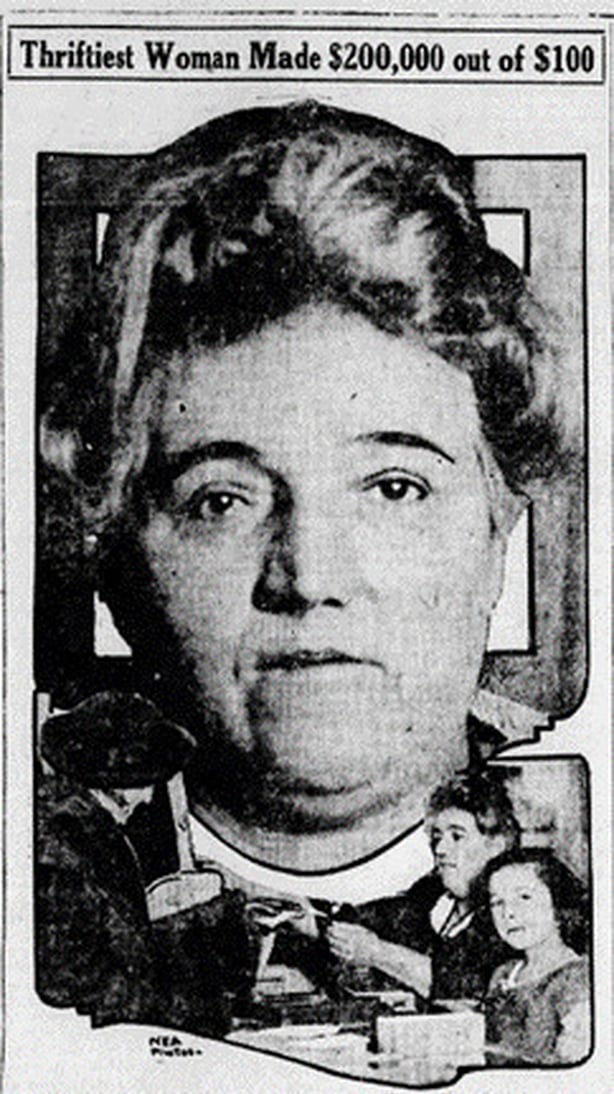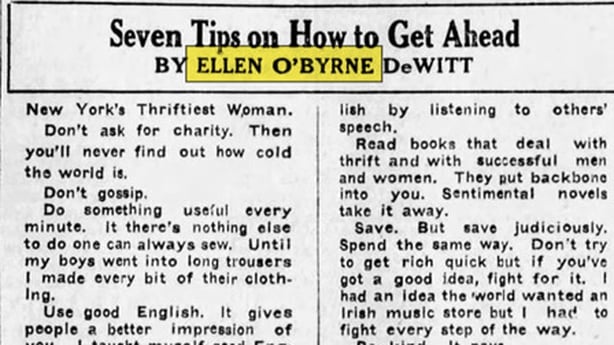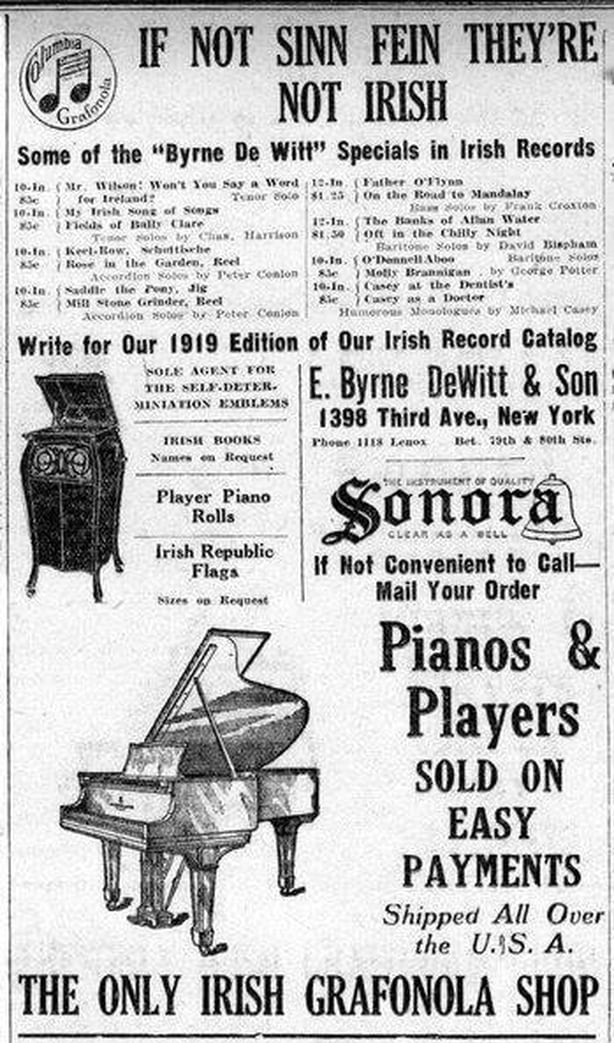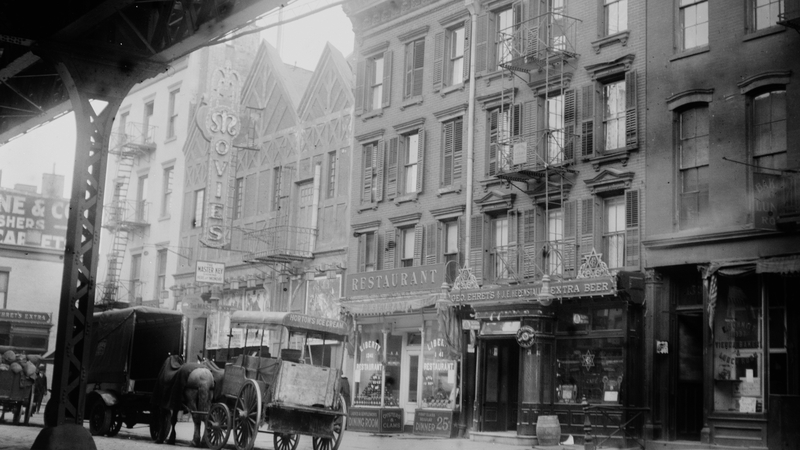Analysis: Ellen O'Byrne's New York business played a key role in recording and distributing Irish music over a century ago
By Michael Mary Murphy, Institute of Art, Design + Technology Dún Laoghaire
How many of Ireland's key industries can claim to have a 'founding mother’? Very few. Yet it’s fair to argue that Ellen O’Byrne, born in 1875, was ‘the founding mother of the Irish record industry.’ From an impoverished background in rural Dromod, Co Leitrim, where she was probably known as O’Beirne, she fled post-Famine Ireland and emigrated to New York. There, as Cathal Funge's excellent RTÉ Radio 1 documentary series Label of Love highlights, she established a business that played a key role in recording and preserving Ireland’s music culture.
In New York, O'Byrne married a Dutch immigrant, Justus DeWitt, and they opened a shop together in Manhattan "despite initial protests from the companies involved", the objections apparently stemmed from the prominence of a woman in the venture. While the husband maintained the accounts, O'Byrne successfully "explored new and enterprising avenues" for the business. The shop sold musical instruments – accordions were a prominent item –and the new cylinder recordings of music also found space on the shelves.
We need your consent to load this rte-player contentWe use rte-player to manage extra content that can set cookies on your device and collect data about your activity. Please review their details and accept them to load the content.Manage Preferences
From RTÉ Radio 1's Label of Love series, Cathal Funge traces the extraordinary story of Ellen O’Byrne DeWitt, the woman credited with single-handedly founding the Irish recording industry
O’Byrne-DeWitt seemed to embody the values of both old Ireland and modern America. She was socially modest and financially successful, and she applied her enterprise skills and vision to capture and preserve a version of Irish culture. Her achievements ensured that Irish music was taken seriously in the early 1900s. Importantly for Ireland, the entrepreneurial activities of Byrne-DeWitt proved that small companies could find a niche in the global recording music industry.
In 1923, a number of US newspapers published features on O'Byrne that presented her as a self-made success story. Readers were informed that she had arrived from Ireland with nothing except "a love [for Irish music] and a little bundle of clothes". Now she was a business-owner whose property was valued at $200,000. By today’s standards she’d be acclaimed as a multi-millionaire.

Naturally, her success in America had implications for her family in Ireland. In the well-established pattern for emigrants, she had paid for her brothers and sisters to leave Ireland and join her in New York. As the newspaper stories recounted, this was in dramatic contrast with her situation in 1911 when O’Byrne was "stranded with $100 in her pocket and a young and hungry son clinging to each hand". With the last of her cash, she had founded a shop and diligently applied herself to the twin responsibilities of being a working mother and a small-business owner. "Until my boys went into long trousers", she said, "I made every bit of their clothing."
By all accounts, O'Bryne was an astute businesswoman and the newspapers reported how she had cleverly accepted US government-issued Liberty bonds during the war in payment for goods when customers were short of actual cash. She used the profits from the shop to buy the building from the landlord. Later, she bought the property next door as well as three houses on Staten Island and five vacant lots suitable for development.
O’Byrne’s perspective as a successful businesswoman had elements of a folksy "how to" manual:
Don’t gossip
Do something useful every minute
Use good English. It gives people a better impression of you.
Read books that deal with thrift and with successful men and women.
Save. But save judiciously.
Be kind. It pays.

Some of her wisdom, though, sounded hard-won and specific: ‘don’t try to get rich quick, but if you’ve got an idea fight for it. I had an idea the world wanted an Irish music store, but I had to fight every step of the way’. If O’Byrne’s success story was, for the media, a way of defining the idea of the American dream, it mattered even more for Irish culture. Firstly, she was a female Irish entrepreneur and an American success story. But even more importantly, she was someone with the means and the ability to actively curate her idea of Ireland’s musical heritage.
Although the article doesn’t mention it, O’Byrne’s shop at 1398 Third Avenue was one of, if not the first, shop in New York selling Irish goods exclusively. Naturally, it became a focal point for the emigrant community. With her knowledge of both her customers and the range of records available, she spotted a gap in the market. People wanted Irish music and, if the major labels wouldn’t treat Irish music seriously, O’Byrne herself would find artists and tunes and get them recorded and distributed.

In 1916, she arranged for the Irish reel The Stack of Barley to be recorded on accordion and banjo and sold hundreds of copies of the disc. Irish traditional music was being recorded, and, in a real sense, being made in the US.
O’Byrne may have educated herself to speak better English to help her to succeed in the US, but some of her business moves were the actions of an ardent Irish nationalist. She changed the name of the shop to the Sinn Féin Music House, and when her label released the patriotic ballad, Kevin Barry, she included the message: "dedicated to all the Fenians living or dead".
O'Byrne’s releases weren’t all political or topical. In fact, you can hear the template for the next five decades of Irish popular music, including the showbands, in her records. There were jigs and reels as well as sentimental songs by the masculine tenor voice that became a hallmark of global Irish culture.
We need your consent to load this YouTube contentWe use YouTube to manage extra content that can set cookies on your device and collect data about your activity. Please review their details and accept them to load the content.Manage Preferences
You could teach Irish geography by using the place names in her song titles: Castlebar, Galway, Mullingar, Clare, Down, Innisfail and Dunloe. There were fun songs and sentimental lyrics about fair maidens, small village Ireland and longing. Above all, there were songs about what it meant to be Irish, and songs about how people wanted Ireland to be.
Sadly, O’Byrne didn’t live long to further the cause of Irish music. One of the great what-might-have-been questions of the Irish music industry is what she could have achieved with a longer career. Perhaps the best way that O’Byrne’s memory could be honoured would be for young Irish women to start record labels and export some of Ireland’s music talent to the world.
This is an edited extract from Sounds Irish, Acts Global: Explaining the Success of Ireland's Popular Music Industry by Michael Mary Murphy and Jim Rogers
Dr Michael Mary Murphy is a lecturer in the Department of Humanities + Arts Management, Entrepreneurship at the Institute of Art, Design + Technology Dún Laoghaire.
The views expressed here are those of the author and do not represent or reflect the views of RTÉ
